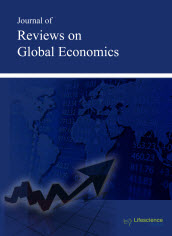jrge
Abstract - Financial Fragility and Central Bank: Are Minsky’s Crisis and Austrian Business Cycle are Complementary?
|
|
Abstract: This article explains why Minsky’s post-keynesian explanation tells only one side of the crisis’ story. Indeed, the financial fragility of markets explains mainly the activity of Central bank i.e. the lender of last resort which increases the moral hazard phenomena and the socialization of risks. The regulated capitalism is, in this perspective, the cause of market instability and financial fragility. Indeed, moral hazard encourages commercial banks to take risks. In that respect, the economic policies implemented to manage the crisis of 2008 are inadequate. Keywords: Economic crisis, Minsky, central bank, capitalism by fiat and financial instability.Download Full Article |
Abstract - Hayek’s Hidden Critique of The General Theory
|
|
Abstract: Hayek is seen as one of the main opponents of Keynes because of the debate about macroeconomics that they had in the early thirties. A few years after this controversy, Keynes published The General Theory ([1936] 1973), and Hayek was expected to criticize Keynes’ new model. But, surprisingly, Hayek decided to remain silent and let his opponent go unchallenged. He regretted it ever after. However, this paper argues that in Hayek’s work after 1936, there is a criticism of The General Theory that to a certain extent has remained unnoticed. Thus, this approach reopens the great debate between Hayek and Keynes just where they had apparently left it, that is, after the publication of The General Theory. Keywords: Keynes, prices, business cycles, macroeconomic policy, unemployment.Download Full Article |
Abstract - Target Capital Structure Determinants and Speed of Adjustment Analysis to Address the Keynes-Hayek Debate
|
|
Abstract: According to F. A. Hayek, Keynes’ General Theory neglects an analysis of the production structure. As a contribution to this research gap, we look at companies’ decisions to finance investments and at their agility to adjust their capital structure. We thus study the relationship between capital structure to finance corporate production and shifts in aggregate demand. Target capital structure determinants and speeds of adjustment to these target capital structures will be analyzed for a geographically comprehensive sample of 2,706 companies listed in Asia, Europe and the U.S.A. in the period 1995 – 2009. Aggregate demand turns out to be the coordinating force which determines managers’ choices of target capital structures. The speed of adjustments towards target capital structures indicate that firms are agile in adapting to their targets. Our results provide evidence on Keynes’ General Theory from a firm level perspective: Firms respond quickly to shifts in aggregate demand by adjusting capital and production structure correspondingly.. Keywords: Keynes, Hayek, capital structure, dynamic adjustment, panel models.Download Full Article |
Abstract - Homoclinic Bifurcation and Endogenous Cycles in the Dynamic IS-LM Model
|
|
Abstract: This paper contributes to the new keynesian literature by showing that stable endogenous cycles can emerge as equilibrium solutions of the traditional IS-LM model. The application of the original Bogdanov-Takens theorem allows us to determine the regions of the parametric space where the model exhibits a global indeterminate solution, and a low-growth trapping region, characterized by a continuum of equilibrium trajectories in the proximity of a homoclinic bifurcation. Keywords: Multiple steady states, homoclinic bifurcation, oscillating solutions.Download Full Article |























